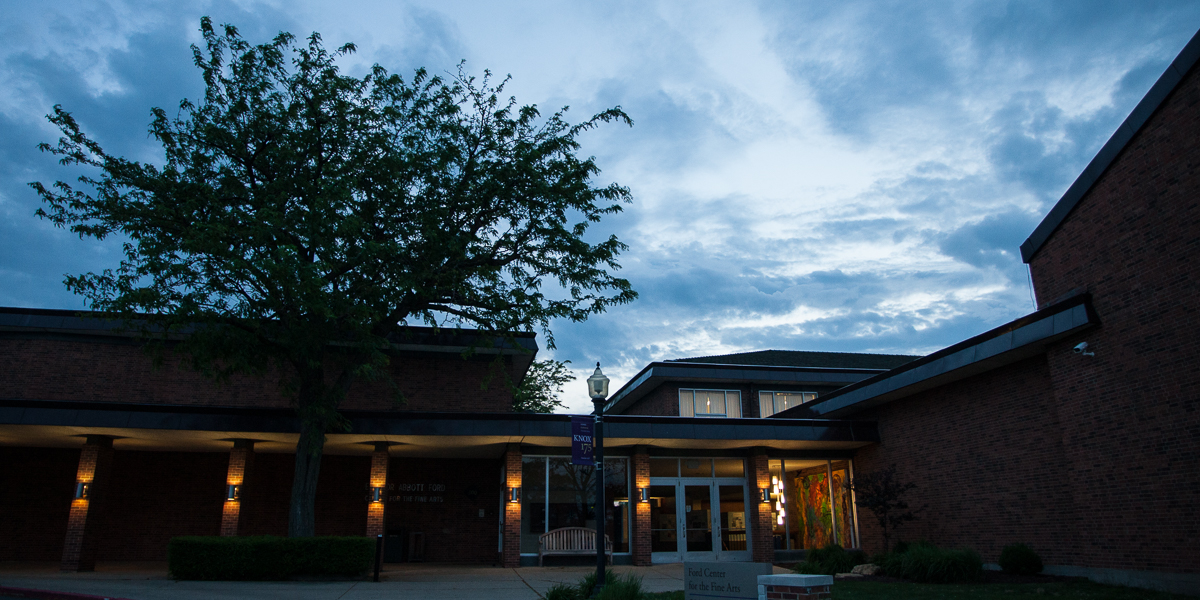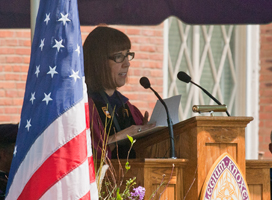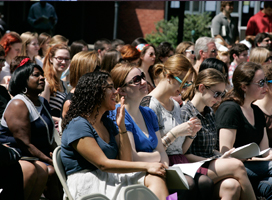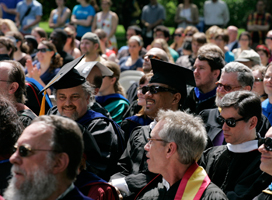


Office of Communications
2 East South Street
Galesburg, IL 61401

 Before I begin, the Knox Prairie Fire baseball team is playing Grinnell this weekend for the division championship. Let’s cheer them on with a loud "Go Knox!" that they can hear all the way to Iowa.
Before I begin, the Knox Prairie Fire baseball team is playing Grinnell this weekend for the division championship. Let’s cheer them on with a loud "Go Knox!" that they can hear all the way to Iowa.
I am honored and humbled to accept the trust placed in me by the Board of Trustees. I pledge all of my energy toward bringing into being the lofty aspirations for Knox presented to me today and entrusted to my care by these representatives of the Knox community.
In this work, I will be empowered by the support of faculty, staff, students, and alumni who constitute this remarkable College and love it with all their hearts.
I will be counseled by the Board of Trustees, who give so generously of their time, talent, and treasure.
I will be sustained by the Galesburg community that has nurtured Knox College for 175 years.
I will be strengthened by the "courage and endurance" of all who shepherded Knox College through those 175 years, including the 18 past presidents, two of whom join us today. Let us together thank President Emeritus John McCall and President Emeritus Roger Taylor, and Anne Taylor. Roger, virtually every day, I turn to Denise Bailey, the miracle-working executive assistant you bequeathed to me, and say, "Denise, what would Roger do?"
But most of all, I will be inspired by the creativity and spirit of our phenomenal Knox students. Knox students, you make me laugh, you make me cry, sometimes you even make me dance.
First, thank yous to all those who made this special day possible. Thank you to Jan Koran, who chaired the Board during the search and the transition, and welcome to Duke Petrovich, who will assume the chair of the Board this July.
To the Presidential Search Committee, led by Richard Riddell, who so embodied the spirit of this community that I was immediately drawn to the position when first I met them.
To the 30 Knox faculty and staff and nearly 100 student volunteers who took on the project of a presidential installation in a year already marked by multiple special events because it is our 175th birthday, and especially to Bev Holmes, our Vice President of Advancement, who volunteered to manage the entire project. Although their names are on the website, that is scant recognition for all they have accomplished.
To the many delegates and special guests today, I thank you for joining us on this occasion.
And behind the scenes, to the many facilities and dining service workers who began their day long before the rest of us and whose work will not be over when these events appear to conclude. To them, my most special thanks. You make these events happen.
The way to Knox for me began when Smith College beckoned to me and I took up residence at the first vibrant and caring liberal arts college community I would ultimately be privileged to join. I will forever be a Smithie -- one of four on the Knox campus -- all of us proud of the commitment to women's education that remains the mission of that extraordinary college in Northampton, Mass.
As many of you know, I have been privileged to work for and belong to many fine liberal arts colleges in addition to Smith before coming to Knox. It was at these places that I developed a love for what is found here: unique in the world, where undergraduate education is our mission, our only mission, and I am grateful to those communities for all they taught me. Especially I am grateful to Mark Gearan, who taught me that the secret to a successful college presidency is to serve the college with humility, and to never, ever believe your own press clips.
Smith was the spark that kindled my academic career, but my real education began at home, which was, for me, spread across four continents. My father, John Crider Amott, is a Midwesterner by birth. While serving his country in the U.S. Diplomatic Corps, he met my mother, Ruth Nascentes Coelho, in Rio de Janeiro, her birthplace, and together, we three journeyed from Bolivia, to Japan, Peru, Honduras, Mexico, Portugal, Germany.
They cannot be here today.
But I am grateful that a fraction of my father's diplomacy and verbal skills and a fraction of my mother's wit and gift for intercultural friendship were passed on to me, so they are here in spirit.
Here today are a group of extraordinary friends who have traveled here from east and west. They have been with me through highs and lows and I am so moved that they have made this journey to Galesburg.
And one last thank you. A college presidency is really a job for two people. Only one has the title, but another shares the burden. I could not do this job without Ray Miller, whose mother and brother also join us today. Chief cook, counselor, dog walker, critic, editor -- mi companero.
 My comments today are framed and inspired by the extraordinary speech contained in your program. The speech that inspired the remarkable piece composed by Daniel Godsil and performed by our wonderful Knox College Choir. The speech was given 75 years ago here by Galesburg's native son, the great American poet and biographer of Lincoln, Carl Sandburg. Sandburg described our pioneering founders as "a fated bridge generation ... moving from a society of farmers and land culture into a machine age" where "scientists would perform the impossible things that until done they were told couldn't be done." The poet tells us:
My comments today are framed and inspired by the extraordinary speech contained in your program. The speech that inspired the remarkable piece composed by Daniel Godsil and performed by our wonderful Knox College Choir. The speech was given 75 years ago here by Galesburg's native son, the great American poet and biographer of Lincoln, Carl Sandburg. Sandburg described our pioneering founders as "a fated bridge generation ... moving from a society of farmers and land culture into a machine age" where "scientists would perform the impossible things that until done they were told couldn't be done." The poet tells us:
"What young people want and dream across the next hundred years will shape history more than any other motivation to be named. Youth now living and youth as yet unborn hold the deeds and the secrets of the folds to be unfolded in the shapes to come."
So today, that is my message as well, a message about the future of Knox, the future to be enacted by today's youth, which is nothing less than the future of the world. Today's students are surely another fated bridge generation, moving us into a global information age where change will be more inclusive and more rapid than ever before in human history. I have said before that I know of no form of education better suited to prepare our students for an uncertain future than a residential liberal arts college. As we think into the future for Knox, we will need to train our vision to see beyond the horizon -- something our pioneering founders surely did as they imagined a town where there was prairie, a college for those without means, and a nation without slavery.
I want to point to three topics on the horizon for Knox. I won't speak at any length about them, but simply flag them for future conversation as we move into strategic planning and a comprehensive campaign for Knox's future.
First, The New Culture of Learning -- learning in a technologically mediated digital world. What will this new culture mean for Knox, an institution deeply rooted in place, in face-to-face interaction?
Second, Diversity and Inclusion in a Global Era -- How can we create thinking globally, but act locally to build inclusive and participatory communities in a world of changing demographics and rapid globalization?
And third, The Sustainability Imperative -- building a culture of sustainability for generations to come. How shall we shape our material environment and our deep culture and psychology to live more gently on the planet?
The phrase "a new culture of learning" comes from a very interesting book by Douglas Thomas and John Seeley Brown, well worth reading if you want to gaze into the strange and baffling horizons of learning. The full title is A New Culture of Learning: Cultivating the Imagination for a World of Constant Change.
Knox is and has been for 175 years a learned community, with a scholarly faculty at our core, a faculty especially distinguished by their sacrificial dedication to Knox students.
The heart of Knox College is this relationship between teachers and students. But in the new culture of learning, we take one step further to a more fluid relationship between teaching and learning -- for in our time together at Knox, we will often exchange roles. In one moment, I might be a teacher, but in the fraction of a second, I can become a learner, my consciousness pierced by the insight of another, my line of sight disrupted by something new or something old seen anew, my convictions undone or affirmed.
For at Knox, we are all teachers, and we are all students. We are all caught up in the culture of learning. Now this is not a new idea, that of students producing knowledge. At the Horizons event this afternoon in the most beautiful college library in America, you will see our students as teachers, as they share with you the products of their learning. Knox pioneered this new culture of learning long ago in the 1920s. What is new, however, is the global and digital flowering of that idea. With today’s and tomorrow’s technologies, this collaborative approach to the construction of knowledge can find full expression.
The new culture of learning is more democratic, more participatory, and less hierarchical than the learning institutions of the past, where students were generally consumers of learning, and faculty producers and transmitters. This week, for instance, Harvard announced that it will join MIT in producing online learning environments with the potential to engage millions of learners.
Over the next few years, I want us to explore more fully the possibilities of the new culture of learning -- what might it mean for those of us who remain committed to learning in place, in an intentional residential community? What could it mean for our curriculum, the way we structure credits and degrees, the boundaries of the academic year? Can we engage alumni in lifelong learning, can we invite into our learning people in other nations, other places? And how do we prepare our students to be active and critical participants in this new culture of learning for the rest of their lives?
Next, Diversity and Inclusion in a Global Era.
The emerging global culture of learning is, by its very nature, diverse, democratic and open. Diversity of participation is made possible by ease of digital access, is a necessary element of the new culture of learning. This, too, extends values that are already present at Knox. When I welcomed the Class of 2015, I told them:
 You will learn the most from the people the least like you. As artists, you will learn from scientists, rural dwellers from city dwellers, young from old, liberals from conservatives, Christians from Muslims, to name only a few of the differences in human experience that you will experience during your education at Knox. This is the beauty of the American liberal arts college -- nowhere else on earth would people so different from one another live together in a community held together solely by learning. A community where students can pursue their intellectual passions, rather than be assigned an occupation by nation, gender, caste or class.
You will learn the most from the people the least like you. As artists, you will learn from scientists, rural dwellers from city dwellers, young from old, liberals from conservatives, Christians from Muslims, to name only a few of the differences in human experience that you will experience during your education at Knox. This is the beauty of the American liberal arts college -- nowhere else on earth would people so different from one another live together in a community held together solely by learning. A community where students can pursue their intellectual passions, rather than be assigned an occupation by nation, gender, caste or class.
We have always valued the learning that happens when people of very different backgrounds come together. At today's ceremony, we were greeted by a parade of nearly 60 flags representing a nation of origin for a current student, staff or faculty member, or a country in which our students and faculty are studying abroad. Each flag representing a nation constructed out of a particular history, with boundaries carved by geography, or mapped by war and conquest, or drawn by force or greed. Each flag symbolizing a culture made up of one or many religions, dances, literatures, languages and songs.
But this wondrous diversity does not always produce the beloved community that Dr. Martin Luther King envisioned for us. Not all feel equally welcomed. So we will need to ask ourselves new questions: what would it look like to move from a world of representation in which members of different groups are statistically present, to a more inclusive and participatory community in which none are marginal, all are central? What if we put these marvelous forms of human difference at the center of our lives together? What would it feel like, and look like, to internationalize the campus itself so that every topic were viewed through and appropriate and emerging global lens? How can we teach our students, our faculty, and staff to engage in difficult intergroup dialogue, on divisive topics, so that we can understand one another’s convictions even as we form from that dialogic process our own commitments? And acting locally, how can we build bridges to our local Galesburg community across differences of age, color, and socioeconomic class?
To help address that question, I am pleased to announce a new partnership with the Galesburg Community Foundation that will place Knox graduates and undergraduates in service positions at Galesburg community agencies over the next year -- the KnoxCorps. The KnoxCorps will model to our entire student body new ways of civic engagement in local communities even as they leverage digital technology and global insights. We will be releasing more details about this initiative in the coming week.
And last, to the Sustainability Imperative. As I gaze out at the multiplicity of these national flags, I am reminded of the Blue Marble, an iconic photograph of the earth floating in space taken by the crew of the Apollo 17 spacecraft nearly three decades ago. From that perspective the earth is singular. There are not hundreds of countries. There are no national borders, no visas, no language barriers. Just one perfect sphere, breathtaking in its wholeness and its fragility. While we must honor and delight in our differences, we must also search for and embrace our common humanity and our common commitment to the planet we inhabit together. To symbolize our campus commitment to sustainability I asked that we add the earth flag, the Blue Marble, to our array of national flags and the Knox flag, and fly it at ceremonial occasions.
I return now to the poet's words:
"What young people want and dream across the next hundred years will shape history more than any other motivation to be named. Youth now living and youth as yet unborn hold the deeds and the secrets of the folds to be unfolded in the shapes to come."
I think that Carl Sandburg would be much at ease with today's Knox students, members of the Millennial generation: the most ethnically and racially diverse cohort of youth in the nation's history and the first for whom digital technologies are everyday parts of their social lives and their search for understanding. Television brought the Vietnam War into my living room as a baby boomer, but now the Internet and the smart phone have brought the world into the palms of our hands.
I believe that their comfort with digital innovation and diversity makes this generation the first in history to have the capacity to be truly global citizens, able to reach beyond parochial interests to appreciate the stakes of our lives together on the planet.
Like the great poet Sandburg, all of us at Knox have hope and faith that this generation, made wise by an education steeped in the great traditions of the residential liberal arts college, can change the world. Unless you take up this challenge, hundreds of millions will die needlessly in violent conflict or childbirth, from hunger or from obesity, through special vulnerability to natural or man-made disasters or from environmental degradation. This and nothing less is what is at stake at Knox as we gaze out onto the far horizons of the future.
And this is why it is such a privilege for me to serve this glorious institution at this remarkable time. Thank you all.